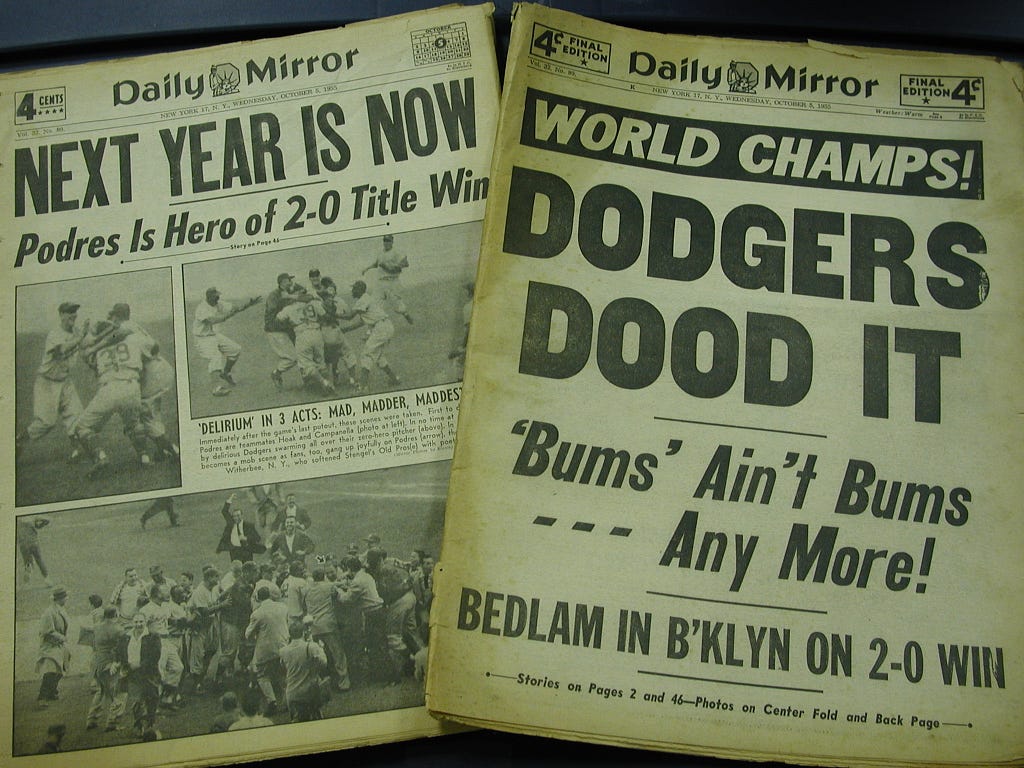
by Mark Langill
As a Philadelphia Phillies pitching coach in the early 1990s, Johnny Podres always grew nostalgic when the team’s bus passed Yankee Stadium on its way to Shea Stadium, the former home of the New York Mets.
In that moment, the instructor with four decades on his pro baseball odometer was 23 years old again, forever the hero of the 1955 World Series when his 2–0 complete game victory gave the Brooklyn Dodgers their first and only championship.
The magnitude of his Game 7 performance led to a statue of Podres’ pitching delivery at Cooperstown, New York, 60 feet, 6 inches from a statue of Roy Campanella, his catcher that afternoon.
Podres isn’t a member of the Baseball Hall of Fame, but coming up big in any World Series Game 7 can ensure legendary status, even in the garden on the grounds of the sport’s shrine.
The Dodgers now stand at the crossroads to history in Game 7 of the World Series at Toronto’s Rogers Centre.
Call it what you will: cementing a dynasty or simply a chance at redemption for letting their home-field advantage slip away in Los Angeles.
A Game 7 victory over the Blue Jays forever washes away whatever slumps or setbacks occurred during the postseason journey. Anyone on the active roster is eligible for hero status.
How many people really heard of reliever Will Klein before Game 3 went to extra innings last week at Dodger Stadium?
Jack Dreyer, Alex Call, Justin Dean, anybody: the stage is yours.
In addition to Podres, the Dodger most associated with Game 7 in 1955 was reserve outfielder Sandy Amoros, who was inserted into left field on a double-switch in the sixth inning when manager Walter Alston moved Jim Gilliam from left field to second base, with the Dodgers clinging to the two-run lead.
Minutes later, the Yankees’ Yogi Berra stepped to the plate with one out, and runners on first and second base. Berra sliced a drive toward the left field corner, the kind of moment that usually spelled Fall Classic doom for the Dodgers against their New York postseason rivals.
Only this time, there was no disaster. Amoros sprinted toward the corner and extended his right arm. The ball landed squarely in the glove. He spun around and started a 7–6–3 double play.
End of threat.
Beginning of legend.
Amoros journeyed to Los Angeles decades later to celebrate the moment at reunion games, whether in 1975 on the 20th anniversary or in 1990 when the Dodgers marked their 100th anniversary as members of the National League.
The Dodgers repeated the Game 7 magic a decade later in Minnesota when Sandy Koufax, like Podres, pitched a complete-game 2–0 victory.
One of the heroes that day at Minnesota’s Bloomington Stadium had no idea of the future impact of having a great Game 7 performance.
Around 2007, former Dodger first baseman Wes Parker had just finished a round of golf at the Los Angeles Country Club when he saw a fleet of limousines entering the parking lot.
Out of the second car emerged President George W. Bush.
“Hello, Mr. President, I’m Wes Parker. I used to play for the Dodgers.”
The six-time Gold Glove winner wasn’t prepared to field Bush’s greeting. Nor did he realize that Bush, a former managing general partner of the Texas Rangers, had closely watched a vintage Dodgers-Minnesota Twins October telecast from 1965.
“Oh sure,” Bush said. “I saw you get two hits last night in Game 7 of the World Series!”
2025 World Series: Dodgers prepare for ultimate Game 7 stage was originally published in Dodger Insider on Medium, where people are continuing the conversation by highlighting and responding to this story.
